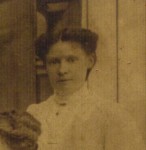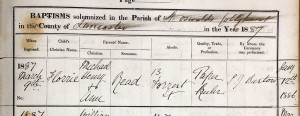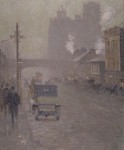 My Great Aunt Florrie died young. My mother thought that she had probably never married. That’s about all I knew about her before carrying out my research.
My Great Aunt Florrie died young. My mother thought that she had probably never married. That’s about all I knew about her before carrying out my research.
According to her baptism record (published on Ancestry.co.uk), she was born Florrie Read on 12th January 1886, and baptized at St. Oswald, Collyhurst on 9th March 1887, over a year later. Why such a late baptism I do not know, but we do know from the record that they were still living at 13 Forrest Street, so it was not an oversight due to a change of address.
 I have been unable to find Florrie on the 1901 census with any variation of her first or second name. It may be that, like my grandmother, she was fostered out while her mother was in the workhouse infirmary and may be listed with a different surname.
I have been unable to find Florrie on the 1901 census with any variation of her first or second name. It may be that, like my grandmother, she was fostered out while her mother was in the workhouse infirmary and may be listed with a different surname.
I think I have found her in 1911, living in the household of the Fawkes family, her occupation given as a cloth stitcher in what looks like ‘Shiping House’. If anyone can tell me what this means, I would be very grateful. My guess is that this was one of the shipping warehouses used for the cotton industry where fabric was prepared for overseas sales. The address is 57 Princess Street, Moston, which is in the Failsworth district, not far from where she was born.
From carrying out searches on Google, I have found that Princess Street is now known as Princedom Street, just below Moston Lane. The street seems like a fairly typical Victorian residential street, but No. 57 no longer seems to exist.
There was a mill at Moston – though it’s a few streets away, and it’s equally possible she could have been working at one of the cotton mills in Hapurhey.
Given that we thought that she had not married, I searched the death records, but found no death record with any variation of her name.
I therefore wondered whether we had been wrong about her being married, so I had a look at the marriage records and I found that a Florrie Read married a Richard T Marsh in 1913. To check this out I searched the death records for a Florrie Marsh, and sure enough, I found that she had died a year later. The burial record states that she was buried on 9th June 1914 at Christ Church in Harpurhey aged 27. This all fits, so I am very confident that this is my Great Aunt.
She died two months before the outbreak of World War I. But why did she die so young? Given that this was just over a year after her marriage I wondered whether she possibly died in childbirth. I decided to order her death certificate to find out.
The address of her residence on the burial record was 6 Lindum Street, Rusholme. This address can be clearly seen on StreetView, and is quite a pleasant looking street opposite a small green.
Did they have children? I checked out the birth registrations, and found a Lucy Marsh born in 1913 with the mother’s surname of Reed, but this turned out not to be their child.
The death certificate told me that she died at this address, of ‘mitral stenosis’. This is a narrowing of the mitral valve in the heart – often caused by rheumatic heart disease, which can occur after rheumatic fever. This is not too surprising, even in one so young. Rheumatic fever was once common in the UK in places of poor sanitation and over-crowding, but is now thankfully rare in this country. In the 19th century, Manchester had one of the highest death rates for diseases of the respiratory system (the sisters’ father had died of pneumonia at the age of 35), and while things had improved by the 20th century, it was still an unhealthy place to live, particularly in the poorer areas.
So what happened to Richard? I could not find a military record for him. He was born in Moston the son of John and Sarah, and was a labourer in a tin yard. He died in 1959 aged 76. He may have married again – there is a marriage in 1937 for a Richard T Marsh and a Bertha Barlow.
While my Great Aunt Florrie did not live through the Great War, she is an example of life in Manchester in the time  that led up to it, and she serves to remind us that, 100 hundred years on, our urban centres are generally far healthier places to live now than they were then.
that led up to it, and she serves to remind us that, 100 hundred years on, our urban centres are generally far healthier places to live now than they were then.
Oxford Road, Manchester 1910. Valette
On a personal note, I now think of my grandmother, who would have been 20 when she lost her older sister. I remember that she was always worried about health and alarmed at each little cold or cough. It’s no wonder, when she lost her father and sister at such early ages to diseases that nowadays are so preventable.

